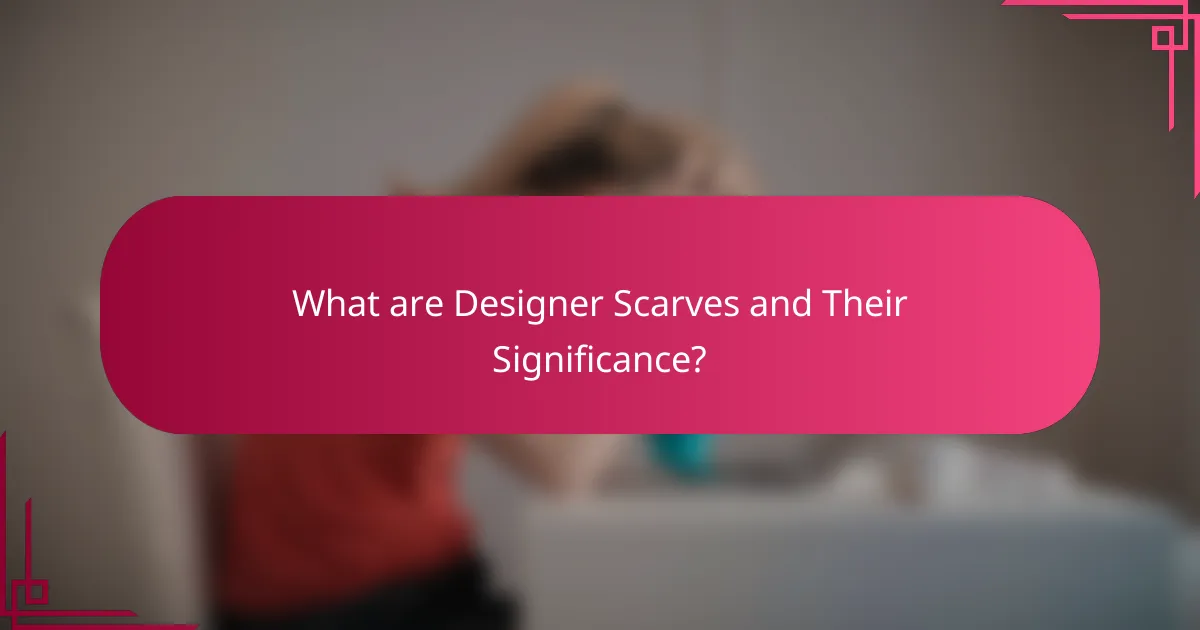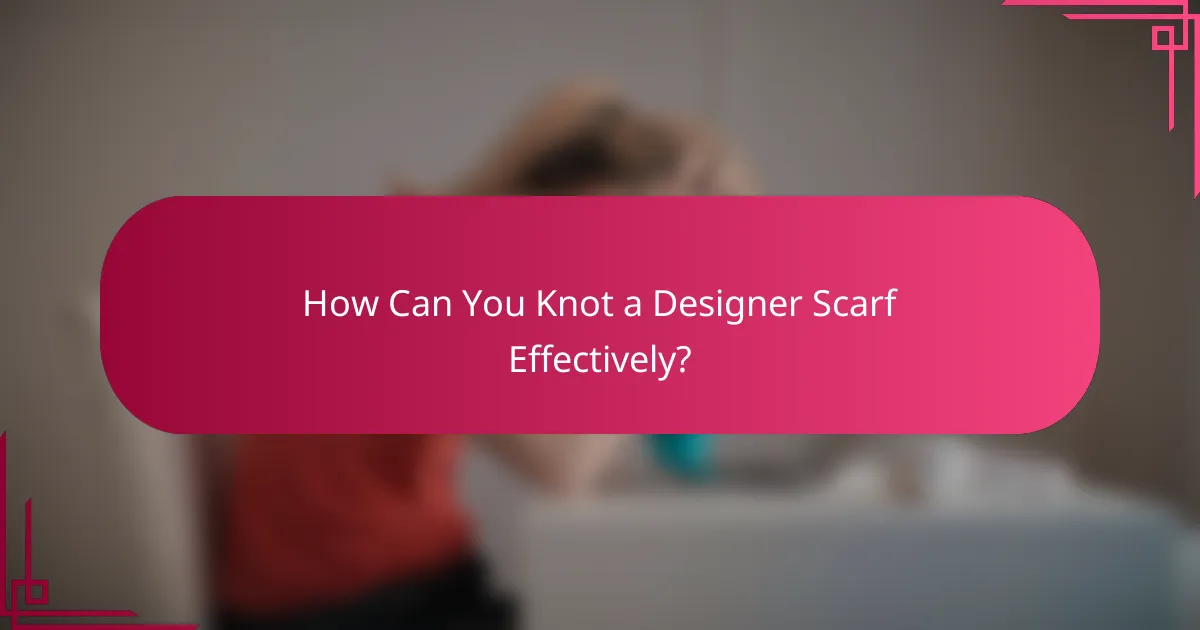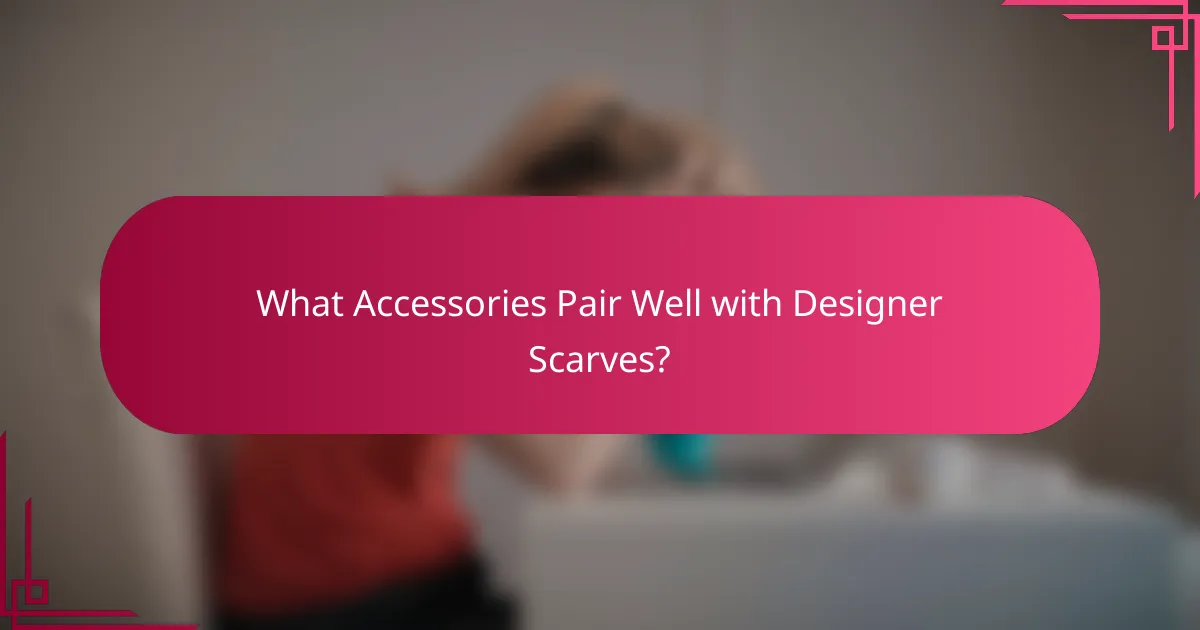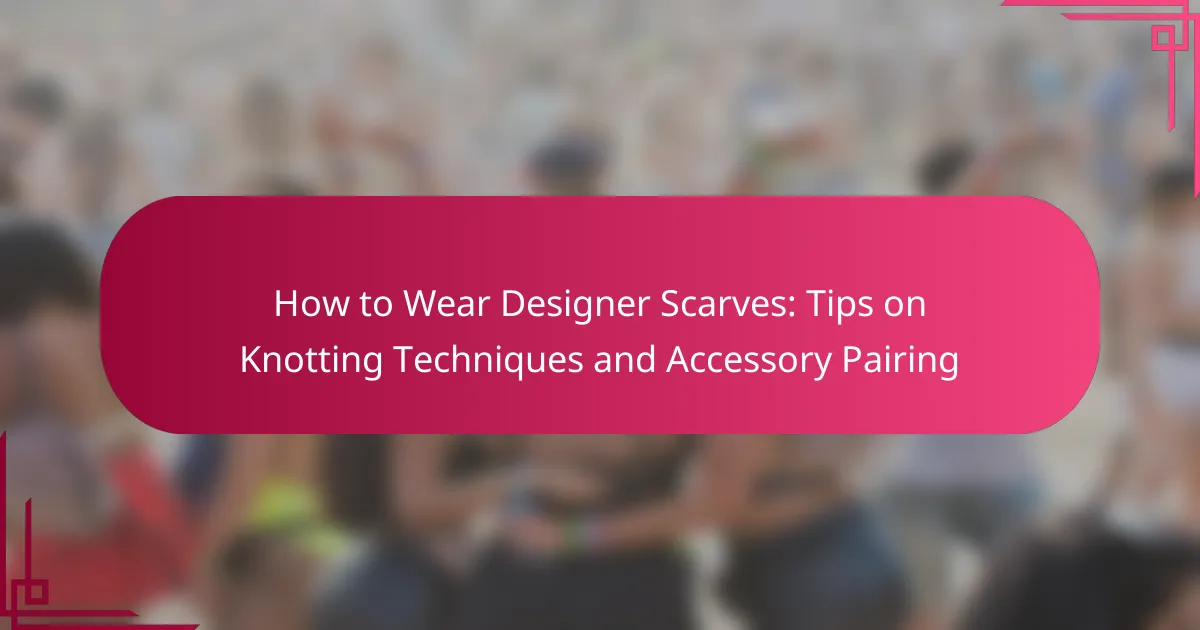Designer scarves are high-quality fashion accessories made from luxurious materials such as silk, cashmere, or wool, created by renowned fashion brands. They serve both functional and aesthetic purposes, enhancing outfits with style and sophistication while also conveying status and personal style. This article provides essential tips on knotting techniques, specifically the loop knot, which offers a simple yet elegant way to wear a scarf. Additionally, it discusses how to effectively pair designer scarves with accessories like jewelry, handbags, and hats to create a cohesive and fashionable ensemble. Understanding these elements will help individuals maximize the impact of their designer scarves in various settings.

What are Designer Scarves and Their Significance?
Designer scarves are high-quality, fashionable accessories often created by renowned fashion brands. They serve both functional and aesthetic purposes. Designer scarves can elevate an outfit, adding style and sophistication. They are often made from luxurious materials like silk, cashmere, or wool. The significance of designer scarves lies in their ability to showcase craftsmanship and brand prestige. Wearing a designer scarf can convey status and personal style. Additionally, they can be versatile, used in various ways such as neckwear, headwear, or bag embellishments. The market for designer scarves reflects consumer demand for luxury fashion items, with some pieces being collectible.
How do designer scarves differ from regular scarves?
Designer scarves differ from regular scarves primarily in quality and branding. Designer scarves are made from high-end materials, such as silk or cashmere. These materials provide a luxurious feel and durability. Regular scarves often use lower-quality fabrics like polyester or acrylic. The craftsmanship of designer scarves includes intricate patterns and unique designs. Many designer scarves feature limited editions or exclusive prints. This exclusivity adds to their appeal and value. In contrast, regular scarves are typically mass-produced with standard designs. The price point of designer scarves is significantly higher due to these factors.
What materials are commonly used in designer scarves?
Common materials used in designer scarves include silk, cashmere, wool, cotton, and linen. Silk is prized for its luxurious feel and sheen. Cashmere offers warmth and softness, making it ideal for colder weather. Wool is durable and provides excellent insulation. Cotton is breathable and versatile for various climates. Linen is lightweight and has a natural texture. These materials are often chosen for their quality and aesthetic appeal in high-end fashion.
Why are designer scarves considered a fashion statement?
Designer scarves are considered a fashion statement because they combine luxury with versatility. These accessories often feature unique designs and high-quality materials. Brands like Hermès and Gucci are known for their distinctive patterns and craftsmanship. Wearing a designer scarf can elevate an outfit, adding sophistication and style. Scarves can be styled in multiple ways, showcasing personal expression. They are often associated with status and wealth, enhancing their appeal. The fashion industry frequently highlights designer scarves in runway shows and editorial spreads. This visibility reinforces their role as a symbol of fashion-forward thinking.
What styles of designer scarves are available?
Designer scarves are available in various styles, including silk, wool, cashmere, and cotton. Silk scarves are known for their luxurious feel and vibrant prints. Wool scarves provide warmth and are often thicker in texture. Cashmere scarves offer softness and insulation, making them ideal for colder months. Cotton scarves are lightweight and breathable, suitable for warmer weather. Additionally, there are infinity scarves, which are looped for easy wear, and square scarves, which can be styled in multiple ways. Each style serves different purposes and occasions, enhancing versatility in fashion choices.
How do different patterns and colors influence scarf choice?
Different patterns and colors significantly influence scarf choice. Colors evoke emotions and can complement or contrast with outfits. For example, bright colors like red can create a bold statement. Patterns such as floral or geometric can reflect personal style and occasion. Classic patterns like stripes or polka dots offer versatility. Seasonal colors, like pastels in spring, guide choices for specific times of the year. Additionally, color theory suggests that certain hues can enhance or diminish skin tones. Overall, patterns and colors play a crucial role in selecting scarves that align with individual preferences and fashion goals.
What are the most popular designer brands for scarves?
The most popular designer brands for scarves include Hermès, Gucci, Louis Vuitton, Burberry, and Chanel. Hermès is renowned for its luxurious silk scarves, often featuring intricate designs. Gucci offers a range of colorful and trendy options, appealing to a younger audience. Louis Vuitton is famous for its iconic monogram patterns on scarves. Burberry is known for its classic check patterns, symbolizing British heritage. Chanel’s scarves often feature elegant designs and timeless aesthetics. These brands are frequently highlighted in fashion publications and are sought after by consumers worldwide.

How Can You Knot a Designer Scarf Effectively?
To knot a designer scarf effectively, start by folding the scarf in half lengthwise. This creates a loop at one end. Drape the scarf around your neck with the loop on one side. Take the loose ends and pull them through the loop. Adjust the knot to ensure it sits comfortably. This method is known as the loop knot. It is simple yet stylish, suitable for various occasions. The loop knot keeps the scarf secure and adds a polished look.
What are the most popular knotting techniques for scarves?
The most popular knotting techniques for scarves include the Parisian knot, the loop knot, and the basic knot. The Parisian knot involves folding the scarf in half and pulling the ends through the loop created. This technique offers a chic and stylish look. The loop knot is created by wrapping the scarf around the neck and tying a simple knot with the ends. This method is practical and keeps the scarf secure. The basic knot is simply tying the ends of the scarf together, which is easy and versatile. These techniques are widely used in fashion for their simplicity and effectiveness in enhancing outfit aesthetics.
How do you create a classic loop knot?
To create a classic loop knot, start by folding the scarf in half to form a loop. Hold the folded section in one hand and the ends of the scarf in the other. Pass the ends through the loop created by the fold. Pull the ends to tighten the knot. Adjust the knot to ensure it is secure and sits comfortably. This knot is commonly used for its simplicity and elegance. It works well with various scarf materials and styles.
What is the best way to tie a Parisian knot?
To tie a Parisian knot, first fold the scarf in half lengthwise. Then, drape it around your neck with the loop on one side. Next, take the loose ends and pull them through the loop. Adjust the knot for desired tightness and position. This technique creates a stylish and elegant look. The Parisian knot is popular for its simplicity and versatility. It works well with various scarf fabrics and styles.
How can knotting styles change the look of an outfit?
Knotting styles can significantly alter the appearance of an outfit. Different knots create varying levels of formality and flair. For example, a simple knot presents a casual look. In contrast, a more intricate knot can add sophistication. The placement of the knot also affects the overall silhouette. A knot at the waist can enhance body shape, while one at the neck draws attention upward. Additionally, the fabric and texture of the scarf interact with the knotting style. A bulky knot can add volume, while a sleek knot maintains a streamlined look. Ultimately, the choice of knotting style allows for personal expression and outfit customization.
What are the effects of different knot placements on style?
Different knot placements can significantly affect the overall style of a scarf. A knot placed at the center creates a balanced look, drawing attention to the face. Conversely, a knot positioned to one side can add asymmetry, giving a more casual or playful vibe. High placements, near the neck, can emphasize the scarf’s fabric and pattern, enhancing sophistication. Low placements can create a relaxed appearance, suitable for informal settings. The choice of knot also influences the silhouette; tighter knots can streamline the look, while looser knots offer a more relaxed feel. Each placement can change the visual weight of the scarf, impacting how it complements the outfit.
How can knot size influence the overall aesthetic?
Knot size significantly impacts the overall aesthetic of a scarf. Larger knots can create a bold, statement look. They draw attention and can serve as a focal point in an outfit. In contrast, smaller knots offer a more subtle and refined appearance. They tend to blend seamlessly with the overall style. The choice of knot size can also influence the scarf’s draping and flow. A larger knot may add volume and structure, while a smaller knot allows for a softer silhouette. Ultimately, the size of the knot plays a crucial role in achieving the desired visual effect in accessorizing with scarves.

What Accessories Pair Well with Designer Scarves?
Jewelry, handbags, and hats pair well with designer scarves. Jewelry can enhance the elegance of a scarf. Statement earrings or layered necklaces complement the look. Handbags add functionality and style. A chic clutch or tote can complete the outfit. Hats, like wide-brimmed styles, can elevate the overall appearance. These accessories create a cohesive and fashionable ensemble. Each accessory type serves to highlight the scarf’s design and color.
How do you choose the right outfit to complement a designer scarf?
To choose the right outfit to complement a designer scarf, start by selecting a base outfit in neutral or solid colors. This allows the scarf to stand out as a focal point. Next, consider the scarf’s color palette and patterns. Match your outfit to one of the colors in the scarf for a cohesive look.
Incorporate textures that complement the scarf’s fabric. For example, pair a silk scarf with a soft cashmere sweater. Accessorize minimally to avoid overwhelming the scarf. Simple jewelry or understated bags work best.
Layering is effective; a tailored blazer or coat can enhance the overall outfit. Lastly, consider the occasion when choosing the outfit. A casual look suits everyday wear, while a more polished outfit is appropriate for formal events.
What types of clothing work best with scarves?
Scarves work best with a variety of clothing styles. They complement casual outfits, such as jeans and t-shirts. Scarves also enhance formal wear, including blazers and dresses. Layering a scarf over a sweater adds warmth and style. Additionally, scarves pair well with outerwear like coats and jackets. They can elevate simple looks and add texture. Scarves serve as versatile accessories, suitable for different occasions. Their adaptability makes them a staple in many wardrobes.
How can you match colors and patterns effectively?
To match colors and patterns effectively, start by using a color wheel. A color wheel shows complementary colors that enhance each other. For example, pairing a blue scarf with orange accents creates a striking look. Next, consider the scale of patterns. Mixing a large floral pattern with smaller stripes adds visual interest without clashing. Stick to a common color palette across all items to maintain harmony. For instance, if a scarf has shades of green, incorporate accessories in similar tones. Additionally, limit the number of patterns to two or three to avoid overwhelming the outfit. This strategy ensures a balanced and cohesive appearance.
What are some tips for accessorizing with designer scarves?
Designer scarves can enhance any outfit when accessorized correctly. Start by choosing a scarf that complements your clothing colors. Consider the fabric type; silk scarves add elegance, while cotton scarves are more casual. Experiment with different knotting techniques to create unique looks. For example, a simple knot can add sophistication, while a looped style can appear more relaxed. Pair scarves with jewelry; a statement necklace can elevate the overall appearance. Use scarves as headbands or belts for added versatility. Lastly, ensure the scarf’s size fits well with your outfit’s proportions.
How can jewelry enhance the look of a scarf?
Jewelry can enhance the look of a scarf by adding visual interest and contrast. Necklaces, for example, can draw attention to the neckline and complement the scarf’s patterns. Statement earrings can frame the face and elevate the overall appearance. Bracelets can add a touch of elegance when the scarf is worn as a head wrap. Additionally, brooches can be used to secure the scarf, creating a stylish focal point. The right jewelry choice can harmonize with the scarf’s colors and textures, enhancing the overall outfit. This layering of accessories creates a more polished and sophisticated look.
What outerwear styles pair well with scarves?
Coats, jackets, and cardigans pair well with scarves. Coats provide warmth and a structured look. They complement scarves by adding layers and texture. Jackets, such as denim or leather, create a casual vibe. Scarves can soften the ruggedness of jackets. Cardigans offer a cozy option for layering. They allow for versatile scarf styling. Outerwear styles enhance the overall outfit when paired with scarves.
What are some common mistakes to avoid when wearing designer scarves?
Common mistakes to avoid when wearing designer scarves include choosing the wrong fabric for the season. Wearing heavy materials in summer can lead to discomfort. Another mistake is neglecting to match the scarf’s color with the outfit. A poorly coordinated color scheme can detract from the overall look.
Overcomplicating the knot is also a frequent error. Simple knots often look more elegant than intricate ones. Additionally, wearing a scarf that is too long or too short for the intended style can disrupt the silhouette. Finally, failing to consider the occasion can lead to inappropriate styling. Casual scarves at formal events may not convey the desired impression.
Designer scarves are high-quality fashion accessories that enhance outfits while showcasing craftsmanship and brand prestige. This article covers essential tips on knotting techniques, including the classic loop knot and Parisian knot, which can significantly alter the aesthetic of an outfit. It also explores how to effectively pair designer scarves with various accessories, such as jewelry and outerwear, while avoiding common styling mistakes. By understanding the significance of materials, patterns, and colors, readers can elevate their fashion choices and express personal style through the versatile use of designer scarves.
